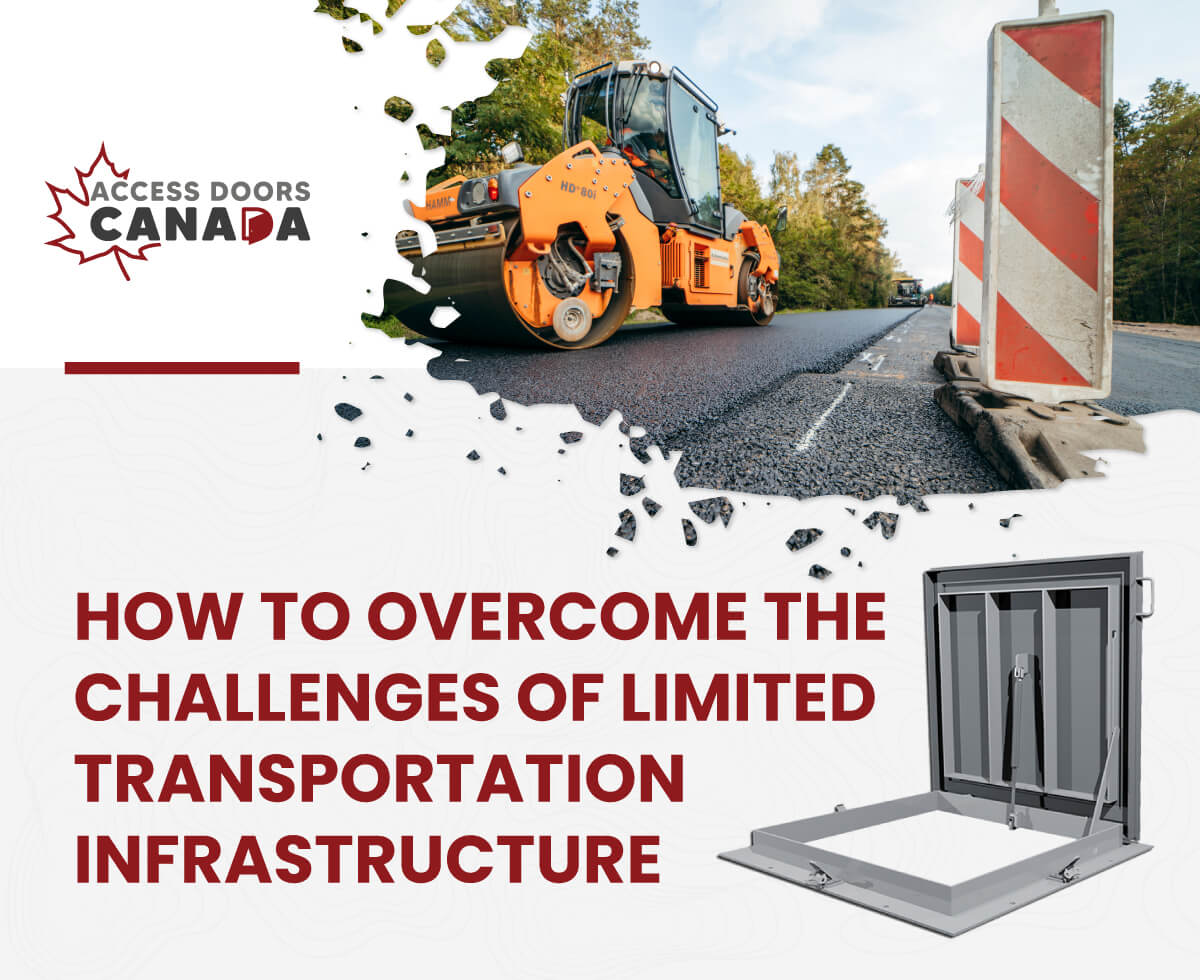How to Overcome the Challenges of Limited Transportation Infrastructure
Canada has one of the most developed national infrastructures in the world. With an extensive network of roads, bridges, and railways, our nation is intricately interconnected, allowing us to transport essential materials with ease. That is - until things go wrong. These systems are an echo from the past, with roots planted as far back as the 19th century, requiring substantial maintenance and upkeep while lacking substantial upgrades. All of this equates to limited transportation infrastructure and short- and long-term consequences.
Due to their efficiency and functionality, these supply chain and transportation relics are often taken for granted, and perhaps we tend to overestimate their effectiveness. However, this optimistic outlook tends to lead to complacency, as demonstrated by recent extreme weather events that have ground our economy, prosperity, well-being, and safety to a halt.
As recently as 2016, the Fort McMurry Wildfires caused catastrophic damage to the community and entire region, with a total of 2,400 homes and buildings- accounting for 85% of the city decimated by the time they were extinguished. In the wake of charred buildings, scared trees, and wrecked homes, $9.9 billion was spent on direct and indirect restoration costs.
If not for the resilience of Fort Mcmurrians and our citizens' generosity, the region could have been crippled and halted—however, the restoration process was immediate and effective and a testimony to our nation's strength and fortitude. The incident was a sobering reminder of the new specter of climate change, its devastating effects, and how quickly things can go awry.
Canada was able to collectively breathe a sigh of relief—until the nightmare was repeated just three years later, with the Alberta Forest fires of 2019 halting transportation, routes, and the energy supply chain. On the other end of the spectrum, Quebec, Ontario, and British Colombia experienced severe flooding and subsequent landslides in the same year, extending to 2021, once again disrupting major highways, railways, and supply chains.
The point is that these patterns—trends of unanticipated, catastrophic weather events are proving to be recurring. They have proven that not only do we face the challenges of the massive costs associated with the maintenance and upkeep of outdated systems, but we must also face the sobering reality that these systems may not be adequately equipped for the challenge of climate change. The costs associated with restoration and repair are likely ten-fold higher than a preemptive, proactive strategy.
Self-Inflicted Wounds
The effects of COVID-19 also thrust the economic impacts of supply-chain stoppages and the infrastructural impacts that loomed immediately on the horizon. However, the inability to adapt and overcome was self-inflicted. COVID-19 only exposed and thrust the main issues directly into the spotlight. According to the Canadian Center for Economic Analysis (CANCEA), Canada’s planned investment in Infrastructure is highly volatile in comparison with its NATO counterparts, suggesting a major lack of foresight and planning. CANCEA has revealed these findings a full two years after the effects of COVID.
CANCEA has also revealed that investment in infrastructure has not been proportionate to GDP growth, further limiting our prospects—while culminating in Vancouver’s national part, the nation’s largest, ranking as the second worst in the world. Two-thirds of Canada’s GDP is reliant on a system that is clearly inefficient, and more than 30% of businesses cite transportation as a barrier to exporting, exceeding 50% in certain regions where infrastructure is a major issue, such as the Prairie provinces, southern Alberta, southwestern British Colombia, and the maritime regions.
Our outdated, limited infrastructure poses major health and economic consequences for the future—and recent history has demonstrated that a proactive, aggressive strategy of innovation and implementation is required to adapt. These adaptations require immediate planning and implementation to overcome one of the ominous issues that our nation faces.
How to Overcome These Challenges? Innovation and Foresight
The frozen highways of the Yukon and Northwest Territories have been relied on for decades as a main vein for medical supplies, groceries, and comforts that sustain each community. However, even the arctic tundra of the Great North is not immune to the effects of rising temperatures.
A relatively recent Climate and Action Energy Report outlined the economic consequences of not addressing greenhouse emissions and rising national temperatures—and the region's response was immediate and innovative. With an initial investment of $22 million, they have successfully implemented a solution known as SMARTICE, which accurately monitors and forecasts ice thickness. These measures and readings provide invaluable insights and allow communities to plan and strategize around the ever-changing and evolving conditions.
The innovation, adaptation, and proactive measures that have been applied by the Yukon and Northwest Territories will pay dividends in the future, as the cost of deteriorating winter roads could result in over $130 million in restoration costs over the next 30 years. By addressing the issue head-on and immediately, these innovations have the potential to maintain and sustain livelihoods and the local economy—and, more importantly, save lives.
Further Adaptations
The rest of Canada needs to take a cue from the north and not be so reliant on the old guard and outdated systems that we have grown so reliant on. From an economic standpoint, the costs required do not always have to be substantial; however, whatever the initial costs are, they are sure to be cheaper than the long-run expenses.
The implementation of an underground infrastructure network is a viable solution to natural disasters while preserving our beautiful lands and preserving the environment. Underground infrastructures are also highly resilient to natural disasters, preserving essential utility systems and technology grids.
They may also be the solution to transportation infrastructure issues, providing an emergency solution in the face of wildfires, floods, landslides, hurricanes, and other natural disasters.
Access solutions such as the ADC-A-FPS Flood Tight Floor Door by Acudor are ideal preventative measures and accessories to improve these infrastructure systems. The ADC-A-FPS is ideal for new and retrofit applications, allowing them to be implemented at any stage of the construction process. This flood-tight floor door is ideal for interior and exterior applications, making it suitable for a range of applications while ensuring safe and secure access for installations and inspections.
In the face of natural disasters and extreme weather conditions such as floods, their watertight seal sustains essential barriers in levees while controlling and preventing water flow, preventing flooding in low-lying areas. Infrastructure systems such as pump stations and underground utility networks such as electrical chambers, vaults, and communication systems will be kept dry, with a sustained access point to vital systems in the event of disasters.
Our inefficient ports can be improved with access solutions like the ADC-A-FPS Flood Tight Floor Door. These ports can be upgraded with advanced technology adoption to track data, locate cargo and endpoints easily, and improve logistics to streamline the process. In addition to maintenance and inspections, a load-bearing, watertight solution is necessary to facilitate these installations. This is the environment where the ADC-A-FPS will excel.
Adapt or Get Left Behind
Our rich and highly diverse ecosystems bring several environmental-related challenges that require foresight, anticipation, and proactive planning and execution. The recent mild and pleasant holiday season has proven to be a red herring, with the nation plunged into arctic temperatures and heavy snowfall just a few weeks later. The extreme weather conditions are here to stay, and these environmental factors will only place a further burden on our infrastructure.
Furthermore, an investment in updating our outdated infrastructure is the first step to preventing and sustaining our economy and well-being. Our ports, our supply chains, our livelihoods, and our safety should not be at the mercy of factors that we can control. With the use of innovation, planning, and the implementation of the right access solutions, integration and maintenance can be achieved efficiently and effectively. The funds and ingenuity are there; all Canada needs now is action.
Access to Efficiency
If you want to learn more about our sustainable access solutions, feel free to connect with our team. You can trust Access Doors Canada to provide the best products available. We also have warehouses near you, ensuring our items are always in stock, for speedy delivery.









